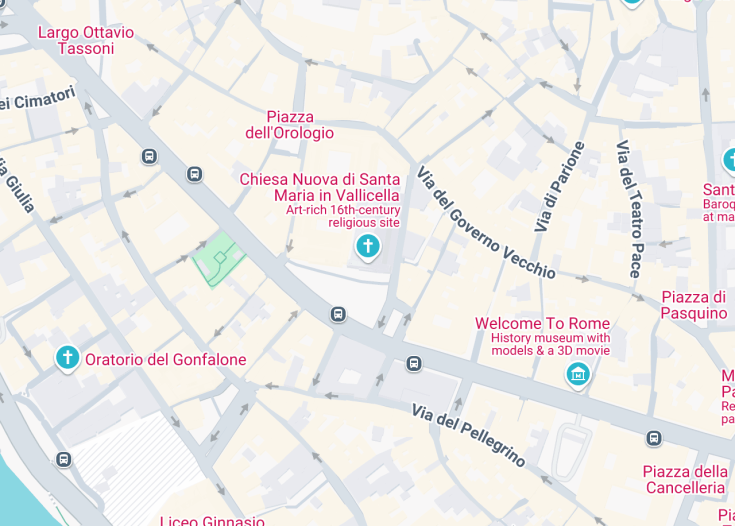Chiesa di Santa Maria in Vallicella, commonly known as Chiesa Nuova, is a prominent Catholic church located in Rome, Italy. Renowned for its baroque architecture, the church is a significant site of religious and artistic heritage, housing remarkable works by famed artists such as Pieter Paul Rubens. Founded in the 16th century by Saint Philip Neri, it serves as a spiritual center within the city and attracts numerous visitors seeking both faith and history.
To fully appreciate the intricate details of the Chiesa Nuova, consider visiting during weekdays when the crowds are thinner. This allows for a more personal encounter with the church’s splendid interiors and its captivating artistic masterpieces.
For those planning a visit to Santa Maria in Vallicella, be sure to check the schedule of special events and masses. Participating in a service can provide a unique glimpse into the church’s vibrant community and deep-rooted traditions.
Chiesa di Santa Maria in Vallicella (Chiesa Nuova) in Rome (Rome), Italy
The Chiesa di Santa Maria in Vallicella, commonly referred to as Chiesa Nuova, is a remarkable example of Roman Baroque architecture. Designed by the architect Matteo di Città di Castello, construction began in 1575 and was completed in 1614, characterized by a harmonious blend of artistic elements that reflect the spiritual fervor of the Counter-Reformation period. The church features a grand façade that showcases paired pilasters and columns, with a prominent central portal surmounted by a triangular pediment housing the statue of the Madonna Vallicelliana. This façade reflects the influence of the Jesuit style, particularly evident in its decorative elements.
Inside, the church boasts a spacious single nave flanked by side chapels, adorned with exquisite stuccos and marble inlays. The vault is stunningly frescoed by Pietro da Cortona, depicting the Assumption and the Holy Trinity, showcasing the artist’s mastery in creating dynamic movement and a luminous atmosphere. The altarpiece features the miraculous Madonna of Vallicella, a focal point of veneration, surrounded by artwork depicting various saints.
The interior is equally captivating with numerous ovals that house biblical scenes, providing a rich tapestry of religious narratives that enhance the visitor’s experience, embodying the intentions of its founder, Saint Philip Neri, who emphasized personal spirituality.
History
13th Century – Early Establishments
The site of the current church was believed to have been previously associated with pagan worship, originally linked with the Tarentum divinity. A church dedicated to the Nativity of the Virgin was documented here as early as the 13th century, which became a focal point of Christian worship.
1575 – Commencement of New Construction
In 1575, Pope Gregory XIII officially assigned the old church to the newly established Congregation of the Oratory, founded by St. Philip Neri. The deteriorating condition of the church necessitated a complete rebuild, with Matteo di Città di Castello receiving the commission for the new structure, leading to the establishment of the Chiesa Nuova.
1600s – Architecture and Decoration
Throughout the later years of the 16th and into the 17th centuries, the church underwent significant modifications. Notable architects like Martino Longhi the Elder and Giacomo della Porta contributed to the redesign and embellishment of the church. The transformation featured the introduction of side chapels and a grand facade completed in 1605.
17th Century – Decadence and Restoration
The church continued to enhance its artistic values with the introduction of frescoes by Pietro da Cortona. Over the years, a series of restoration efforts took place, particularly during the 20th century, culminating in significant renovations around 2006 that revitalized both the internal and external structures.
Experiencing the Chiesa di Santa Maria in Vallicella
Visitors to Chiesa Nuova can explore the breathtaking interior, observing the frescoes that encapsulate the Baroque artistry of the era. The church also hosts religious services and special events, offering an opportunity for engagement with its spiritual atmosphere. The adjacent Oratory of St. Philip Neri provides further insights into the life and teachings of its founder, enhancing the overall experience of pilgrims and tourists alike.
Noteworthy Aspects of Chiesa di Santa Maria in Vallicella
A significant feature of the church is the Madonna Vallicelliana, a miraculous image that is said to have miraculously bled when struck by a stone. This event in 1535 elevated the painting to a renowned status, leading to its placement as the altarpiece, becoming a pilgrimage destination and deeply entwining the church’s history with the spiritual life of its visitors.
General informations
Location
Chiesa di Santa Maria in Vallicella, often referred to as Chiesa Nuova, is situated in the heart of Rome, within the vibrant rione Parione. It boasts proximity to landmarks such as Piazza Navona and is easily accessible via public transportation.
Address:
Via del Governo Vecchio, 134, 00186 Roma RM, ItalyVisiting Information
The church is open to the public, allowing visitors to experience its rich history and stunning baroque architecture at their convenience. To avoid large crowds and ensure a peaceful visit, it is recommended to come during the early morning or late afternoon.
How to reach Chiesa Nuova
Car
The Chiesa di Santa Maria in Vallicella is easily reachable by car. However, parking in the vicinity can be limited. Nearby parking garages are available for those who choose to drive.
| Route | Distance | Travel time |
|---|---|---|
| From Roma Termini | 2 miles (3.2 Km) | 15 minutes |
| From Piazza Navona | 0.5 miles (0.8 Km) | 10 minutes |
| From Vatican City | 1 mile (1.6 Km) | 20 minutes |
Public Transport
The Chiesa Nuova can also be reached via public transportation. The closest bus stop is a short walk away, served by various lines connecting to major areas of the city.
Accessibility and Limitations
The Chiesa di Santa Maria in Vallicella is generally accessible to visitors; however, due to its historical nature, some areas may present challenges for individuals with mobility issues.
Accessibility
Limitations
- Limited seating may be available for longer visits.
- Special events or services may restrict visitor access during certain times.
Notes to visitors
- Photography is allowed but may be restricted during services.
- Visitors are advised to dress modestly out of respect for the sacred space.
Common questions
What are the main architectural features of Chiesa Nuova?
Chiesa Nuova, officially known as Santa Maria in Vallicella, exemplifies the Baroque architectural style prominently. The church features a striking façade characterized by two levels of paired columns and semi-columns, which create an elegant yet grand visual effect. The central portal is accentuated by a large semicircular tympanum that houses a statue of the Madonna Vallicelliana.
Inside, the church boasts a single nave flanked by two smaller aisles and a series of stunning chapels. The ceiling is adorned with a magnificent fresco by Pietro da Cortona, depicting the Madonna and Saint Philip Neri, which enhances the spiritual atmosphere. The use of colorful marbles and intricate stucco work adds to the church’s lavish interior. The altar is another highlight, featuring an exquisite altarpiece by Peter Paul Rubens, making it a focal point for visitors.
What notable artworks can be found at Chiesa Nuova?
Chiesa Nuova is a treasure trove of art, housing several significant masterpieces that attract both art lovers and tourists. Among the most notable is the altarpiece created by the renowned artist Peter Paul Rubens, which represents the Virgin Mary and the Child Jesus surrounded by adoring angels. This piece is a unique blend of religious piety and artistic expression.
In addition to Rubens’ work, the church features a collection of Baroque frescoes by Pietro da Cortona, especially the ceiling artwork that depicts divine scenes involving the intercession of the Virgin Mary. Furthermore, various chapels within the church contain exquisite paintings, such as those by the Cavalier d’Arpino, which depict important figures in Christianity and serve as a testament to the artistic heritage of the period.
Are there any unique cultural practices associated with Chiesa Nuova?
Chiesa Nuova, or Santa Maria in Vallicella, is associated with a variety of cultural and religious practices that reflect its significance in the Catholic community. One of the unique elements is the tradition surrounding the celebration of mass by the Congregation of the Oratory, founded by Saint Philip Neri, whose spiritual gatherings often include distinct musical elements, fostering a deeply communal and worshipful experience.
The church also celebrates various feast days and events dedicated to the Virgin Mary, where rituals may include processions, special masses, and exhibitions of the beloved Madonna Vallicelliana. These events not only enhance the spiritual life of the church but also allow visitors to witness the vibrant traditions of Catholic worship in Rome.
What is the significance of the Madonna Vallicelliana?
The Madonna Vallicelliana is an iconic image housed within Chiesa Nuova, known for its miraculous historical background. This 14th-century fresco became a revered icon after reports emerged of it bleeding when struck by a stone, significantly enhancing its status as an object of veneration. The story of its miraculous powers drew pilgrims and worshippers, leading to the church’s prominence.
Today, the image occupies a focal point on the main altar, encased in a beautifully designed frame by Rubens that highlights its importance. Visitors often come to pray before this revered image, seeking intercession and healing, which speaks to the deep-rooted faith and cultural significance of this artwork within the Catholic community in Rome and beyond.
What can visitors expect from the interior decoration of Chiesa Nuova?
Upon entering Chiesa Nuova, visitors are greeted by an opulent interior that reflects the grandeur of Baroque aesthetics. The main nave, lined with rich stuccoes and illuminated by a series of colorful marble columns, creates a dramatic atmosphere that draws attention. The ceiling features stunning frescoes by Pietro da Cortona, which narrate scenes connected to Mary and the life of Saint Philip Neri.
Moreover, the richly decorated chapels on either side of the nave display intricate designs and significant artworks, inviting visitors to marvel at the craftsmanship. These chapels, each with their unique decorations, contribute to a sense of layered beauty and spirituality throughout the church.
In addition, the placement of stained glass windows allows natural light to enhance the visual experience inside, making it a must-see for anyone appreciating sacred art and architecture.

Is the Chiesa di Santa Maria in Vallicella (Chiesa Nuova) in Rome worth visiting?
The Chiesa di Santa Maria in Vallicella, also known as Chiesa Nuova, is certainly worth a visit for anyone exploring Rome. This striking church showcases exquisite baroque architecture and is home to incredible artworks, including masterpieces by Peter Paul Rubens and stunning frescoes by Pietro da Cortona. Its rich history, dating back to the 16th century, adds to its allure, making it a significant site not just for religious reasons but also for cultural heritage. Visitors can admire the intricate details of the façade and the beautifully decorated interiors, including the impressive altar adorned with the famous Madonna Vallicelliana. Additionally, its location in the vibrant Parione district provides an opportunity to explore nearby attractions. Make sure to include this gem in your itinerary!










